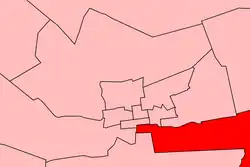Denver (House of Assembly of South Africa constituency)
| Denver | |
|---|---|
| Former constituency for the South African House of Assembly | |
 Location of Denver within Johannesburg (1910) | |
| Province | Transvaal |
| Electorate | 3,158 (1929) |
| Former constituency | |
| Created | 1910 |
| Abolished | 1933 |
| Number of members | 1 |
| Last MHA | Frederic Creswell (Lab) |
Denver was a constituency in the Transvaal Province of South Africa, which existed from 1910 to 1933. It covered parts of the inner eastern suburbs of Johannesburg, centred on the suburb of Denver. Throughout its existence it elected one member to the House of Assembly and one to the Transvaal Provincial Council.
Franchise notes
When the Union of South Africa was formed in 1910, the electoral qualifications in use in each pre-existing colony were kept in place. In the Transvaal Colony, and its predecessor the South African Republic, the vote was restricted to white men, and as such, elections in the Transvaal Province were held on a whites-only franchise from the beginning. The franchise was also restricted by property and education qualifications until the 1933 general election, following the passage of the Women's Enfranchisement Act, 1930 and the Franchise Laws Amendment Act, 1931. From then on, the franchise was given to all white citizens aged 21 or over. Non-whites remained disenfranchised until the end of apartheid and the introduction of universal suffrage in 1994.[1]
History
Denver was a largely working-class seat, and was closely fought between the Labour Party and various non-socialist candidates. Its final and most notable MP - the only one to represent the seat for more than a single term - was Labour leader Frederic Creswell, who moved there in 1924 after briefly representing the Durban seat of Stamford Hill. The seat was abolished in 1933, at which point Creswell moved to Bellville in the Cape Town suburbs.
Members
| Election | Member | Party | |
|---|---|---|---|
| 1910 | Donald Macaulay | Unionist | |
| 1915 | W. J. Parrack | ||
| 1920 | T. E. Drew | Labour | |
| 1921 | C. E. Nixon | SAP | |
| 1924 | Frederic Creswell | Labour | |
| 1929 | |||
| 1933 | Constituency abolished | ||
Detailed results
Elections in the 1910s
| Party | Candidate | Votes | % | ±% | |
|---|---|---|---|---|---|
| Unionist | Donald Macaulay | 866 | 57.1 | New | |
| Labour | T. Landye | 652 | 42.9 | New | |
| Majority | 214 | 14.2 | N/A | ||
| Unionist win (new seat) | |||||
Elections in the 1920s
| Party | Candidate | Votes | % | ±% | |
|---|---|---|---|---|---|
| South African | C. E. Nixon | 961 | 42.9 | +12.7 | |
| Labour | T. E. Drew | 696 | 31.0 | −14.2 | |
| National | J. J. B. Pohl | 585 | 26.1 | +1.6 | |
| Majority | 265 | 11.9 | N/A | ||
| Turnout | 2,242 | 68.2 | −1.6 | ||
| South African gain from Labour | Swing | +13.5 | |||
References
- ^ "EISA South Africa: Historical franchise arrangements". Eisa.org.za. Archived from the original on 9 May 2013. Retrieved 6 July 2012.
- ^ Schoeman, B.M. (1977). Parlementêre verkiesings in Suid-Afrika 1910-1976. Pretoria: Aktuele Publikasies.
- ^ Standard Encyclopaedia of Southern Africa (1972). "House of Assembly" (vol. 5, pp. 617–636). Cape Town: Nasionale Opvoedkundige Uitgewery (Nasou).